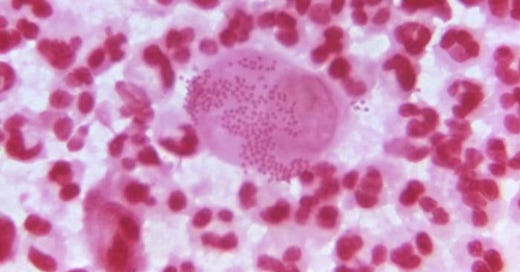The UK Health Security Agency (UKHSA) reported a drop in gonorrhea cases from 2023 to 2024, according to recently published data.
Officials report 71,802 diagnoses of gonorrhea in 2024, compared to 85,370 in 2023, a 15.9 percent decrease. Young people aged 15 to 24 years accounted for a 36% reduction in diagnoses, the most of all age groups.
However, an increase in diagnoses of antibiotic-resistant gonorrhea cases (Ceftriaxone resistance) are reported.
UKHSA says there have now been 14 cases reported in the first 5 months of 2025, which is greater than the number of cases reported for the whole of 2024 (13 cases). Six of the 14 cases in 2025 have been extensively drug-resistant cases, which means that they were resistant to ceftriaxone and to second-line treatment options.
Most ceftriaxone resistant cases are associated with travel to or from the Asia-Pacific region, where the prevalence of ceftriaxone resistance is high.
Ceftriaxone-resistant Neisseria gonorrhoeae (the bacterium that causes gonorrhea) was first detected in England in 2015. By May 19, 2025, a total of 52 cases had been reported in England, 18 of which were extensively drug-resistant (XDR, resistant to first- and second-line antibiotics).
Data on other sexually transmitted infections in England include:
infectious syphilis diagnoses increased 1.7% from 9,375 in 2023 to 9,535 in 2024; considering all syphilis diagnoses, including late stage or complications such as ocular and otosyphilis, diagnoses increased 4.6% from 12,456 in 2023 to 13,030 in 2024
gonorrhea diagnoses decreased 15.9% from 85,370 in 2023 to 71,802 in 2024
chlamydia diagnoses decreased by 13.0% from 194,143 diagnoses in 2023 to 168,889 diagnoses in 2024
first episode genital warts diagnoses decreased 4.3% from 26,193 in 2023 to 25,056 diagnoses in 2024
new STI diagnoses decreased 8.8% from 399,947 in 2023 to 364,750 in 2024
the diagnosis rates of STIs remain greatest in young people aged 15 to 24 years; gay, bisexual and other men who have sex with men (GBMSM); and some minority ethnic groups





